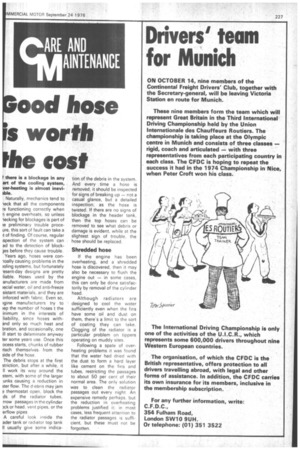ood hose s worth he cost
Page 229

If you've noticed an error in this article please click here to report it so we can fix it.
there is a blockage in any art of the cooling system, ver-heating is almost ineviible.
Naturally, mechanics tend to neck that all the components re functioning correctly when n engine overheats, so unless lecking for blockages is part of le preliminary trouble proceure, this sort of fault can take a t of finding. Of course, regular spection of the system can ad to the detection of blockes before they cause trouble. Years ago, hoses were conirony causing problems in the )oling systems, but fortunately .esent-day designs are pretty
Hoses used by the anufacturers are made from )ecial water, oil and anti-freeze sistant materials, and they are inforced with fabric. Even so, igine manufacturers try to )ep the number of hoses t the inimum in the interests of liability, since hoses withand only so much heat and bration, and occasionally, one ill start to delaminate anyway ter some years use. Once this ocess starts, chunks of rubber )tach themselvesfrom the side of the hose.
The debris stops at the first striction, but after a while, it II work its way around the stem, with some of the larger unks causing a reduction in iter flow. The debris may jam a thermostat open, block the ds of the radiator tubes, rrow passages in the cylinder )ck or head, vent pipes, or the erflow pipes.
A careful look inside the ader tank or radiator top tank II usually give some indica tion of the debris in the system. And every time a hose is removed, it should be inspected for signs of breaking up — not a casual glance, but a detailed inspection, • as the hose is twisted. If there are no signs of blockage in the header tank, then the top hoses can be removed to see what debris or damage is evident, while at the slightest sign of trouble, the hose should be replaced.
Shredded hose
If the engine has been overheating, and a shredded hose is discovered, then it may also be necessary to flush the engine out — in some cases, this can only be done satisfactorily by removal of the cylinder head.
Although radiators are designed to cool the water sufficiently even when the fins have some .oil and dust on them, there's a limit to the sort of coating they can take. Clogging of the radiator is a particular problem on tippers operating on muddy sites.
Following a spate of overheating problems it was found that the water had dried with the dust to form a hard layer like cement on the fins and tubes, restricting the passages to about 50 per cent of their normal area. The only soluton was to clean the radiator passages out every night. An expensive remedy perhaps, but the reduction in overheating problems justified it; in most cases, less frequent attention to the radiator passages is sufficient, but these must not be forgotten. •




































































































































































































































































































































































